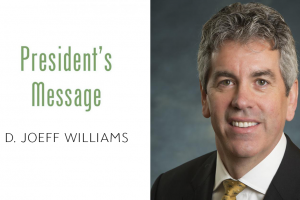By Steve Alpert
As I start my year as president, I am looking to forward to advancing the Academy’s mission, as described in its short yet powerful mission statement: “To serve the public and the United States actuarial profession.” The two elements of the Academy’s mission statement—service to the public and service to the profession—do not represent separate and distinct sets of responsibilities. The service that we actuaries provide—using our actuarial skills while upholding the high standards of professionalism—forms the basis of the services that the profession undertakes for the public and of the value the public places on actuaries.
That value derives from the public’s need to trust that financial security programs can meet their obligations. The professional commitment of actuaries—to act with integrity, to be competent, to play by the rules, to subject ourselves to discipline when we do not—helps to build the public’s trust and confidence that these critical programs can deliver the promised financial security and reduce concerns about risks to life, health, property, or retirement.
Who is “the public”? What does it mean to “serve” the public?
To begin with, I consider “the public” to be ordinary people. They are the ordinary people in the United States who drive cars and own homes, who try to stay well and sometimes get sick, who work hard and then retire, who live and worry about what will happen to their families when they die. Other entities, such as corporations or governments, have their own important perspective and objectives, but for my purposes “the public” means people living their lives day-to-day and trying to mitigate the risks of an uncertain future. Ultimately, the public benefits from our work, even though that work may be paid for directly by someone else (whom we call our principal).
When we talk about “serving the public,” we are obviously not talking about a drive-through window where consumers sidle up to buy actuarial services. The Academy’s Committee on Professional Responsibility explains: “The actuarial profession has a responsibility to the general public … [but] this does not mean that an individual actuary is personally responsible to each member of the general public regardless of whether the actuary has a professional relationship to, or has sought to influence, that person. Rather, it means that actuaries who comply with the Code and meet their appropriate professional responsibilities to principals and other users of the actuary’s work product indirectly benefit the general public as well.”
The members of the public whom we serve rely on financial security programs such as insurance, pensions, and health care. They need these programs to be trustworthy, to be there when needed, and to keep their promises.
One of the distinguishing features of a financial security program, however, is that it is not a “traditional” market transaction in which both parts of an exchange happen essentially simultaneously, such as in the sale and receipt of goods. In such a transaction, both participants generally consider the outcome to be fair at the moment the transaction is executed. When we talk about markets, we use terms of freedom, equality, and current expectation: “free market” or “fair value,” for example.
By contrast, I see the actuarial questions for a financial security program relating to terms like risk or guarantee: “reasonable estimates” or “capital requirements.” In a financial security program, the member of the public makes an upfront payment (such as payment of an insurance premium) and receives a promise of a future payment or other benefit. The amount and timing of the future payment, or both, are contingent upon some uncertain event.
To illustrate this contrast further, consider an ordinary coin toss. Assume that you pay $1 to toss a coin, and you will receive $2 if it is heads and nothing if it is tails. Because the expected value of the payout (1/2 x $2) is equal to $1, this is a fair game and somewhat akin to a traditional market transaction.
Now suppose instead the price of tossing the coin were $1 million, and the payout for heads were $2 million. You would want some assurance that the program provider—the counterparty on the other side of the bet—had the wherewithal to make good on the $2 million payment. You would probably want to know whether the provider of this program were well-enough capitalized so that it could pay—even, for example, if you were to get three or four heads in a row. You would probably also want to know whether the provider’s business practices were sustainable over some relevant time horizon and whether the provider would be able to keep the promise of payment, particularly if you paid for the right to flip the coin upfront but did not actually flip it until sometime later.
But, what if you were not in a position to know those things on your own? Even if you could intuit them for the relatively simple case of a coin flip, what if instead you were looking at a financial security program, with many different participants, contingencies, timing, and potential outcomes?
These additional complexities, risks, and range of possible outcomes—the actuarial questions—mean that ordinary people need help beyond “fair market value” to figure out whether a program does indeed provide financial security and peace of mind.
Enter the actuarial profession—and the professionalism of actuaries. That’s right: professionalism, not just smarts. It is not enough for actuaries to be smart to garner the public’s trust. To have confidence in their financial security programs, the public needs to be able to trust actuaries and the information we provide to our principals and regulators. We earn that trust by following the precepts of the Code of Professional Conduct.
In the abstract, if you were looking for advice or information on a potentially life-altering decision, what attributes might you consider to be worthy of your trust? A few that come to mind include:
Honesty. Does the potential adviser tell the truth? What can be verified? Do the explanations for what cannot be verified seem well-reasoned and plausible?
Integrity. Are interests well-defined and potential conflicts of interest disclosed? Does the potential adviser demonstrate, through word and action, adherence to principles?
Consistency. Do the same (or similar) circumstances always produce the same (or similar) conclusions?
Reliability. Does the potential adviser follow through on commitments—saying what he or she will do, doing what he or she says?
Open communication. Does the potential adviser communicate clearly about data, methods, reasoning, and appropriate use? Is everything expressed in understandable terms?
Norms and standards. Do they exist? Does the potential adviser follow them? If not, why? How does the community enforce them?
Ability to assess and communicate risk. What does the potential adviser envision as the possible futures? What are the potential risks—upside and downside? Does the potential adviser make clear all the potential consequences of any decisions a member of the public might make?
Adaptability. Does the potential adviser adapt to changing circumstances or the availability of new information?
Actuaries are bound by a Code of Professional Conduct that incorporates all of these attributes, expressly or implicitly. Consider just a few examples:
Precept 1 explicitly requires honesty and integrity.
Precepts 2 and 3 require actuaries to meet standards of qualification and practice, which help ensure consistency, reliability, and that actuaries adapt to change.
Precept 4 requires clear communication.
Precept 13 defines the community enforcement of norms.
The value of the actuarial services we provide depends on the core values of actuarial professionalism: honesty, integrity, competence, objectivity, and a commitment to service. When we embody these values in our daily work, we build the public’s trust in what we say and their confidence that the financial security programs upon which they rely will be there when needed.
This brings us full-circle back to the Academy’s mission statement. Actuaries, by word and action, serve the public by assuring the public that the promises of financial security programs will be met. The public’s trust is hard-earned, one small step at a time, but can be easily lost with only one action. This is one of the reasons that Precept 1 of the Code of Professional Conduct puts the responsibility to the public and the reputation of the profession front and center.
Over the next year, I look forward to engaging Academy members in a fuller discussion of how our collective commitment to professionalism can serve the public and the profession.





